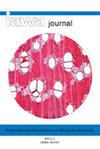Stem anatomy of Apioideae (Apiaceae): effects of habit and reproductive strategy
IF 1.4
3区 农林科学
Q2 FORESTRY
引用次数: 1
Abstract
Apioideae is the biggest and the most diverse of four subfamilies recognised within Apiaceae. Except for a few, likely derived, woody clades, most representatives of this subfamily are herbaceous. In the present study, we assessed stem anatomy of 87, mostly therophytic and hemicryptophytic, species from at least 20 distinct lineages of Apioideae, and juxtaposed them with 67 species from our previous anatomical projects also focused on this subfamily. Comparing our data with the literature, we found that wood anatomy does not allow for a distinction between apioids and their close relatives (Azorelloideae, Saniculoideae), but more distantly related Mackinlayoideae differ from Apioideae in their perforation plate type. Vessel element and fibre length, and vessel diameter were positively correlated with plant height: phenomena already reported in literature. Similar pattern was retrieved for vertical intervessel pit diameter. Wood ground tissue in apioids ranges from entirely fibrous to parenchymatous. The shortening of internodes seems to favour the formation of parenchymatic ground tissue, whereas the early shift to flowering promotes the deposition of fibrous wood in monocarpic species. These results support a hypothesis on interdependence among internode length, reproductive strategy, and wood ground tissue type.蜜蜂科昆虫的茎解剖:习性和繁殖策略的影响
apiioideae是Apiaceae四个亚科中最大和最多样化的。除了少数可能衍生的木质枝外,这个亚科的大多数代表都是草本的。在本研究中,我们评估了来自至少20个不同的Apioideae谱系的87种(主要是热生和半隐生)的茎解剖,并将它们与我们之前的解剖项目中的67种进行了比较。将我们的数据与文献进行比较,我们发现木材解剖不允许区分apioids及其近亲(Azorelloideae, Saniculoideae),但更远亲的Mackinlayoideae与Apioideae在穿孔板类型上有所不同。导管元素、纤维长度和导管直径与株高呈正相关,这一现象已有文献报道。垂直血管间坑直径也有类似的规律。类阿片类的木屑组织从完全纤维到薄壁组织不等。节间的缩短似乎有利于实质地面组织的形成,而在单果木种中,早期向开花的转变促进了纤维木材的沉积。这些结果支持节间长度、繁殖策略和木材地面组织类型之间相互依赖的假设。
本文章由计算机程序翻译,如有差异,请以英文原文为准。
求助全文
约1分钟内获得全文
求助全文
来源期刊

IAWA Journal
农林科学-林学
CiteScore
3.40
自引率
15.80%
发文量
26
审稿时长
>36 weeks
期刊介绍:
The IAWA Journal is the only international periodical fully devoted to structure, function, identification and utilisation of wood and bark in trees, shrubs, lianas, palms, bamboo and herbs. Many papers are of a multidisciplinary nature, linking
 求助内容:
求助内容: 应助结果提醒方式:
应助结果提醒方式:


